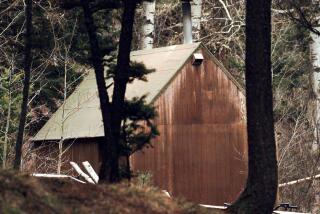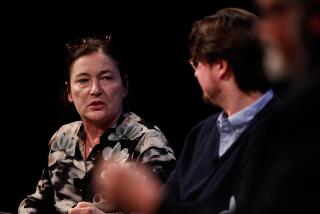Wading through the murky waters of life
Norman Maclean, who died in 1990, was a big two-hearted writer in several respects: He had one foot planted firmly in fiction, the other in nonfiction; his life was one of perennial migration between the urbane setting of Chicago and the rough-hewn environs of a lake in Montana; professionally, he was an academic of 45 years’ standing who took to writing principally after his retirement. There is a river that runs through Maclean’s work, a strong and dark current of defeat, and if we needed further proof of that, both from his self-testimony and as evidenced in previously unpublished writing, it has arrived in the form of “The Norman Maclean Reader.”
Those who have read “Young Men and Fire,” Maclean’s nonfiction reconstruction of the 1949 Mann Gulch fire in Montana, in which 13 smokejumpers were burned to death, may recall the multiple parallels Maclean drew between their fate and that of the 7th Cavalry troops under George Armstrong Custer at the Little Bighorn, another death-dealing Montana site. “In the dry grass on both hills are white scattered markers where the bodies were found, a special cluster of them just short of the top, where red terror closed in from behind and above and from the sides. The bodies were of those who were young and thought to be invincible by others and themselves,” Maclean wrote. “None were surer they couldn’t lose than the Seventh Cavalry and the Smokejumpers.”
The “Reader” contains two striking outtakes from “Young Men and Fire,” one of which includes the Custer-site comparison; the other, printed as a free-standing story titled “Black Ghost,” was used as the very opening of “Young Men and Fire.” It was found among Maclean’s papers after his death (the book itself was published posthumously and so represents decisions made by others) and is a gripping account of one of his own firefighting experiences, caught with flame in front of him, behind him and overhead as well, his shoelaces smoldering by the time he gained safety. As if in psychic contact with the dead of Mann Gulch, Maclean writes, “As a fire up a hillside closes in, everything becomes a mode of exhaustion -- fear, thirst, terror, a twitch in the flesh that still has a preference to live, all become simply exhausting.”
The surprise here is to learn that the Custer comparisons were hardly incidental: From 1959 to 1963, primarily, Maclean struggled to write a book about the battle of the Little Bighorn and its cultural afterlife, and “The Norman Maclean Reader” presents five heretofore unpublished extracts from his manuscript, including sections of what was to be his conclusion, titled “Shrine to Defeat.”
The importance of this material does not lie in historical import: Its unfinished nature is self-evident, as is its heavy reliance on other accounts, including Mari Sandoz’s “Cheyenne Autumn,” and further it pales in comparison with fully developed works such as Evan Connell’s “Son of the Morning Star.” It is better regarded as an illumination of the way Maclean thought -- his concern that the bodies of the men on the hillside, naked except for bloody socks, “have been transformed into a universe of other meanings” -- and it reveals some of his humor as well.
Looking analytically at the narratives that arose around the battle, Maclean writes, “We can get an early glimpse of the mind’s preference to construct history more by the principles of literature than by the canons of evidence” -- this dovetails with his belief that particular moments of life are highly aestheticized, and in fact present themselves as art. On the humorous side, he reports witnessing a mother and son in front of a display case in the museum at the battlefield. In it was the cadet uniform that Custer had worn at West Point (where he finished last in his class), and the mother “whispers to her son that he must study hard in school if he expects to get anywhere in life.” In a chapter on the Sioux, he recounts that when Sitting Bull finally led his followers onto the reservation, he was given 12 acres of plowed land and instructed to become a farmer; ordered to pick up a hoe, he complied and took a few strokes with it. “In the joke book of history, this must be rated among the better laughs,” Maclean comments.
Maclean’s attempt to construct a narrative in tragic form, in accordance with Aristotelian ideas, can be seen as underpinning most of his work, whether it was called fiction or nonfiction. In one of the letters that constitute the latter portion of this reader, he is found confiding to the Western historian Robert Utley that “I am trying to show that our psychological need to deal with defeat is an ultimate common magnetic power that has drawn so many people to this rather small encounter in military history,” an idea he universalized in the “Shrine to Defeat” section of his manuscript, where he asserts that “much of seemingly ordinary and uneventful life is spent marching and counter-marching over the scenes of previous defeats and in fortifying ourselves against those to come.”
Here, of course, one thinks of Maclean’s novella “A River Runs Through It,” the story of a trinity -- a father and two sons -- broken by the murder of one son at its end, which closely parallels the real-life trauma Maclean and his father suffered over the murder of Norman’s younger brother, Paul (the name borne by his fictional counterpart as well). An eight-page excerpt from the novella appears in the reader, inset within a longer talk Maclean delivered, published here for the first time. Ostensibly about “incident” in narrative, it is also revelatory of the relationship between reality and imagination in Maclean’s work. He says of himself and his father, “In the end all we knew -- really knew -- about him [Paul] was that he was beautiful and dead and we had not helped.” A comment of his father’s in life -- “It is those we live with and love and should know who elude us” -- appears verbatim in the fiction (not in the portion excerpted) as the novella closes.
In fact, one effect of the reader is that one comes away convinced that the fictional patina in Maclean’s stories is rather thin, that they are more highly autobiographical than would be expected, given comments of Maclean’s that one of his main interests has been in demonstrating on a technical level how things were done -- whether packing a mule train in his Forest Service novella “USFS 1919: The Ranger, the Cook, and a Hole in the Sky” or fly-fishing in “A River Runs Through It” -- and the fact that he puts the word “stories” in quotations in his letters and describes them as reminiscences. In an essay titled “The Woods, Books, and Truant Officers,” partly an account of his home-schooling by his preacher father, partly a digression on rhythm in language, he says the stories were meant to record not only the manual aspect of labor, but “how it felt to do those things well.” Further, he admits of “USFS 1919” in an interview reprinted in the reader that “everything in the story happened to me in the Bitterroots.” Allow for dramatic conflation or rearrangement of material, change a name or a setting, and we have New Journalism under another rubric.
Lastly, perhaps, we should turn to an academic-literary junction, for Maclean was a longtime professor of English at the University of Chicago, and his study and interest in the Romantic poets have him often referring to Wordsworth’s concept of “Spots of Time.” Maclean was given to recollect brief points of his own past “as if shaped by a poet or storyteller,” and in the excerpted portion of “Young Men and Fire” you find similar sentiment, “a storyteller’s belief that at times life takes on the shape of art and that the remembered remnants of these moments are largely what we come to mean by life.” Not only does the idea crop up in his letters, too, you will find an allusion to “spots of time” in “A River Runs Through It” and the commingling of art and life in “USFS 1919,” as if there were an Einsteinian equation at work between matter and narrative energy.
Much of “The Norman Maclean Reader” should be seen as material ancillary to Maclean’s masterworks but explanatory and illuminative of themes that he tried to work out -- a process that interfered with his output, incidentally, of which he was well aware, as relayed intermittently in his correspondence. (One exception is a wonderful story titled “Retrievers Good and Bad,” an early working-out of the tragedy of his brother’s death through a discussion of various duck-hunting dogs, which holds its own whether Maclean had written another word or not.) The biggest tragedy of all, one that underlies the mystery of Maclean’s brother’s life, the unknowns surrounding Custer’s actions and the questions embedded in the crosses at Mann Gulch, is pointed to by Maclean in one of his letters when he admitted, “It is clear to me now that the universe in its truculence doesn’t permit itself to be that well known.”
More to Read
Sign up for our Book Club newsletter
Get the latest news, events and more from the Los Angeles Times Book Club, and help us get L.A. reading and talking.
You may occasionally receive promotional content from the Los Angeles Times.








